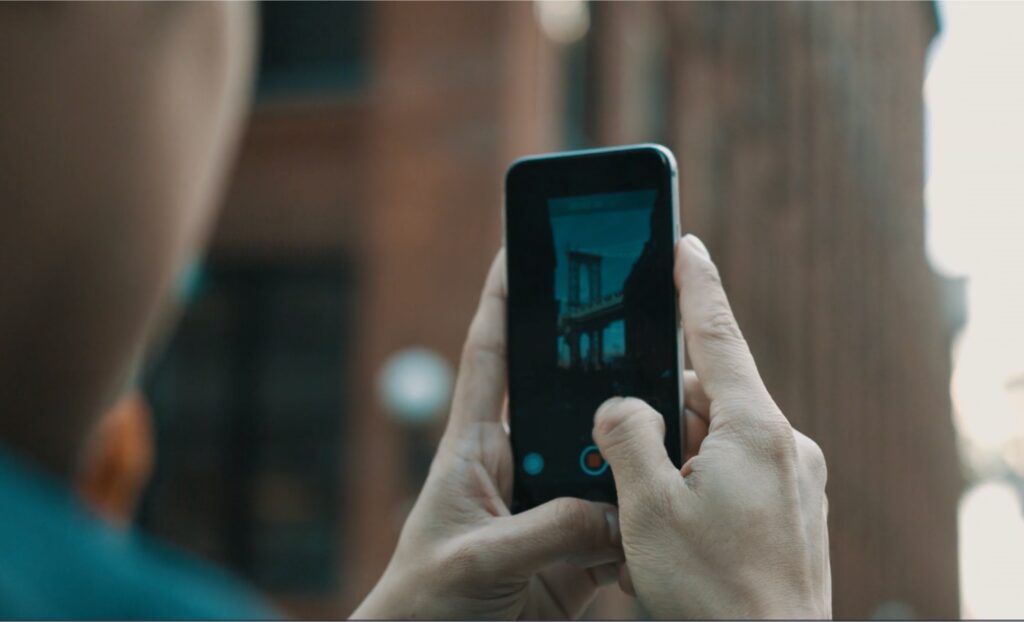Smartphones have revolutionised the way we consume content, with vertical videos gaining immense popularity. While horizontal videos still dominate TV and YouTube, social platforms such as Instagram Stories, TikTok, and Snapchat have embraced vertical content.
Optimising your videos for mobile devices is crucial in today’s mobile-centric world. With mobile video consumption on the rise, it’s essential to tailor your content to meet the preferences of mobile users.
In this article, we will explore the rise of vertical videos in mobile content consumption and why they should be an integral part of your video marketing strategy.
The Rise of Vertical Videos in Mobile Content Consumption
The advent of smartphones has revolutionised the way we consume content, and one of the notable changes is the rise of vertical videos. Gone are the days when horizontal screens were the norm for digital cameras. With the widespread use of smartphones, vertical videos have become the default format for capturing and sharing moments.
Vertical videos align perfectly with the natural orientation of smartphones, making it easier for users to create and consume content in portrait mode. This shift has resulted in a significant increase in mobile video consumption. Platforms such as Instagram Stories, TikTok, and Snapchat have embraced the vertical video format as the preferred mode of content delivery.
As mobile video consumption continues to skyrocket, it’s crucial for content creators and marketers to adapt to this trend. By embracing vertical videos, businesses can effectively engage with their target audience and deliver a more immersive and engaging viewing experience. This shift to vertical content opens up new possibilities for creative storytelling and allows brands to connect with their audience in meaningful ways.
The Benefits of Vertical Videos for Mobile Users
- Enhanced User Experience: Vertical videos offer a seamless and intuitive viewing experience on mobile devices, eliminating the need for users to rotate their screens.
- Optimised for Social Media Platforms: Social media platforms, such as Instagram, TikTok, and Snapchat, have embraced the vertical video format, making it easier for brands to reach their target audience on these platforms.
- Improved Brand Engagement: Vertical videos capture the attention of viewers more effectively, resulting in increased engagement and higher retention rates.
- Increased Visibility: By utilising vertical videos, brands can make their content stand out in a sea of horizontal videos, attracting more views and interactions.
In summary, the rise of vertical videos in mobile content consumption has transformed the way we create and consume video content. With the prevalence of smartphones and the popularity of social media platforms, optimising videos for vertical viewing is essential for businesses to effectively engage with their target audience and maximise their reach and impact.

Why Vertical Video Should Be a Key Part of Your Content Strategy
Vertical videos are no longer just a trend; they have become an integral part of effective content strategies. With the increasing dominance of mobile devices and the rise of social media platforms, optimising your video content for a mobile-friendly experience is crucial for engaging your target audience.
One of the main reasons why vertical videos should be a priority in your content strategy is their performance on social media platforms. Platforms like Instagram Stories, TikTok, and Snapchat have embraced vertical videos as the preferred format, giving them prominent placement and encouraging users to consume and engage with this type of content. Vertical videos provide a more immersive and visually appealing experience for users, increasing their engagement and retention.
By incorporating vertical videos into your content strategy, you can create a more personalised and intimate connection with your audience. Vertical videos take up the full screen on mobile devices, capturing users’ attention and immersing them in the content. This creates a deeper engagement and allows you to deliver your message more effectively.
Benefits of including vertical videos in your content strategy:
- Enhanced engagement: Vertical videos provide a more immersive and visually appealing experience, capturing users’ attention and encouraging them to interact with your content.
- Increased reach: Optimising your videos for mobile devices and social media platforms allows you to tap into a wider audience and maximise your reach.
- Better storytelling: The vertical format allows you to tell your story in a more natural way, taking advantage of the full screen and creating a seamless narrative flow.
- Improved conversion rates: Studies have shown that vertical videos can lead to higher conversion rates, as they offer a more engaging and interactive experience for viewers.
Incorporating vertical videos into your content strategy is essential for staying ahead in today’s mobile-centric world. By taking advantage of the unique benefits that vertical videos offer, you can enhance engagement, increase reach, and ultimately drive better results for your business.
Best Practices for Creating Vertical Videos
Creating compelling vertical videos is essential for effectively engaging your audience and optimising your video content for smartphone viewing. Here are some best practices to consider when creating vertical videos:
1. Keep it short and attention-grabbing
With the short attention spans of mobile users, it’s crucial to hook them right from the start. Keep your videos concise and focus on captivating your viewers within the first few seconds. Use visually striking imagery, compelling text, or captivating audio to grab their attention and keep them engaged throughout the video.
2. Incorporate camera movements and transitions
Adding camera movements and smooth transitions can enhance the visual appeal of your vertical videos. Experiment with panning, tilting, or zooming in and out to add dynamics to your shots. Transitions such as fades, cuts, or slides can also help maintain viewer interest and make your video more visually appealing.
3. Optimise your shots for the vertical format
When shooting your videos, remember to film in a vertical layout to ensure that your footage fits seamlessly within smartphone screens. Vertical shots work best for capturing subjects or scenes that are taller than they are wide. Avoid essential information in the top and bottom portions of the video, as these areas may get cut off when displayed on mobile devices.
4. Edit for the 9:16 aspect ratio
To ensure that your vertical videos appear properly on various platforms, edit them to fit the 9:16 aspect ratio. This way, your videos will be optimised for full-screen vertical viewing. Use video editing software to resize and crop your footage to the appropriate dimensions, ensuring a seamless viewing experience for your audience.
By following these best practices, you can create visually appealing and engaging vertical videos that resonate with your target audience and maximise the impact of your video content.
Vertical Video Distribution and Platforms
When it comes to distributing vertical videos, social media platforms are at the forefront. Instagram Stories, TikTok, and Snapchat have all embraced vertical content as their default format, making horizontal videos appear out of place. These platforms are specifically designed for mobile consumption, and vertical videos provide a seamless and immersive viewing experience for users. By creating content specifically tailored for vertical viewing, you can maximise engagement and reach on these platforms.
Instagram Stories is a popular choice for vertical video distribution. With over 500 million daily active users, it offers a massive audience for your content. The platform allows users to share photos and videos that disappear after 24 hours, providing a sense of urgency and exclusivity. TikTok, on the other hand, has exploded in popularity, especially among younger demographics. It focuses on short-form vertical videos, often with creative and entertaining content. Snapchat, known for its disappearing messages, has also embraced vertical videos as a primary format.
While these platforms are the primary outlets for vertical video distribution, it’s important to note that repurposing vertical videos for other platforms may require adjustments. YouTube, for example, is still primarily a horizontal video platform. To accommodate this, you can add black bars on the sides of your vertical videos or edit them to fit a horizontal aspect ratio. Similarly, if you want to share your vertical videos as regular posts on Instagram feed, you may need to crop or resize them to fit the square or landscape format.
Key Takeaways:
- Instagram Stories, TikTok, and Snapchat are the primary platforms for vertical video distribution.
- These platforms offer a seamless and immersive viewing experience for mobile users.
- Repurposing vertical videos for other platforms may require adjustments to accommodate different orientations.
By leveraging the power of social media platforms and optimising your content for vertical viewing, you can effectively engage your target audience and maximise the impact of your video marketing efforts.
The Impact of Vertical Videos on Conversion Rates
Vertical videos have revolutionised the way companies approach video marketing. With the rise of mobile video consumption, incorporating vertical videos into your marketing strategy can have a significant impact on conversion rates.
According to Google, campaigns that include videos have seen 10-20% more conversions compared to strictly horizontal campaigns. Vertical videos provide a more immersive and engaging viewing experience on mobile devices, leading to increased audience engagement and higher conversion rates.
By embracing vertical videos, you can effectively engage your target audience and boost your marketing results. Vertical videos perform exceptionally well on social media platforms, where most mobile users spend their time. Platforms like Instagram Stories and TikTok have embraced vertical content as the preferred format, making it essential for businesses to optimise their video content for a vertical layout.
The Benefits of Vertical Videos for Conversion Rates:
- Enhanced engagement: Vertical videos provide a seamless viewing experience on mobile devices, capturing users’ attention and increasing engagement.
- Mobile-friendly: With the majority of online users accessing content from their smartphones, vertical videos are the perfect format for delivering a mobile-friendly viewing experience.
- Higher conversion rates: The immersive nature of vertical videos leads to increased audience engagement and ultimately higher conversion rates, making it a valuable tool for businesses looking to drive conversions.
Experimenting with vertical video content can help businesses unlock the full potential of their video marketing strategy and achieve their conversion goals. By following best practices for creating vertical videos and distributing them on platforms that embrace this format, businesses can effectively engage their target audience and drive more conversions.
Conclusion
Vertical videos have revolutionised the way we engage with mobile audiences. With the increasing popularity of social media platforms and the rise of mobile video consumption, optimising your content for a vertical format is crucial. By implementing best practices and creating content specifically tailored for vertical viewing, you can effectively captivate your target audience and enhance your video marketing strategy.
Mobile-friendly videos are no longer a mere afterthought; they are a necessity in today’s digital landscape. The immersive and engaging nature of vertical videos on mobile devices can greatly improve audience engagement and conversion rates. By embracing the vertical video revolution, you can unlock the full potential of your video content and optimise it for maximum impact.
Video content optimisation plays a pivotal role in ensuring that your vertical videos resonate with your target audience. Keeping your videos short, incorporating attention-grabbing hooks, and utilising transitions and camera movements can hold viewers’ interest and keep them engaged. Additionally, editing your videos to fit the 9:16 aspect ratio and avoiding important information in the top and bottom portions of the video are crucial for a seamless viewing experience.
As you delve into the world of vertical videos, consider the dominant platforms in vertical video distribution, such as Instagram Stories, TikTok, and Snapchat. These platforms have embraced vertical content as their default format, making horizontal videos seem out of place. Creating content specifically designed for vertical viewing on these platforms can maximise engagement and ensure that your videos seamlessly integrate with the platform’s user experience.
FAQ
Q: How have smartphones changed content consumption?
A: Smartphones have changed content consumption by popularising vertical video. Most social platforms, such as Instagram Stories, TikTok, and Snapchat, have embraced vertical content.
Q: Why are vertical videos more popular on mobile devices?
A: Vertical videos are more popular on mobile devices because smartphones have a natural vertical orientation, making it easier for users to create and consume content in portrait mode.
Q: Why should vertical videos be a part of my content strategy?
A: Vertical videos perform exceptionally well on social media platforms, providing a more immersive and engaging experience for users. Incorporating vertical videos can greatly enhance engagement and reach with your target audience.
Q: How can I create effective vertical videos?
A: When creating vertical videos, keep in mind that they are primarily consumed on mobile devices. Keep your content short, use attention-grabbing hooks, incorporate transitions and camera movements, film in a vertical layout, and edit to fit the 9:16 aspect ratio.
Q: Which platforms are best for distributing vertical videos?
A: Instagram Stories, TikTok, and Snapchat are some of the primary platforms for vertical video distribution. These platforms have embraced vertical content as their default format.
Q: What impact do vertical videos have on conversion rates?
A: According to Google, campaigns that include videos have seen 10-20% more conversions compared to strictly horizontal campaigns. Vertical videos provide a more immersive and engaging viewing experience on mobile devices, leading to increased audience engagement and higher conversion rates.





